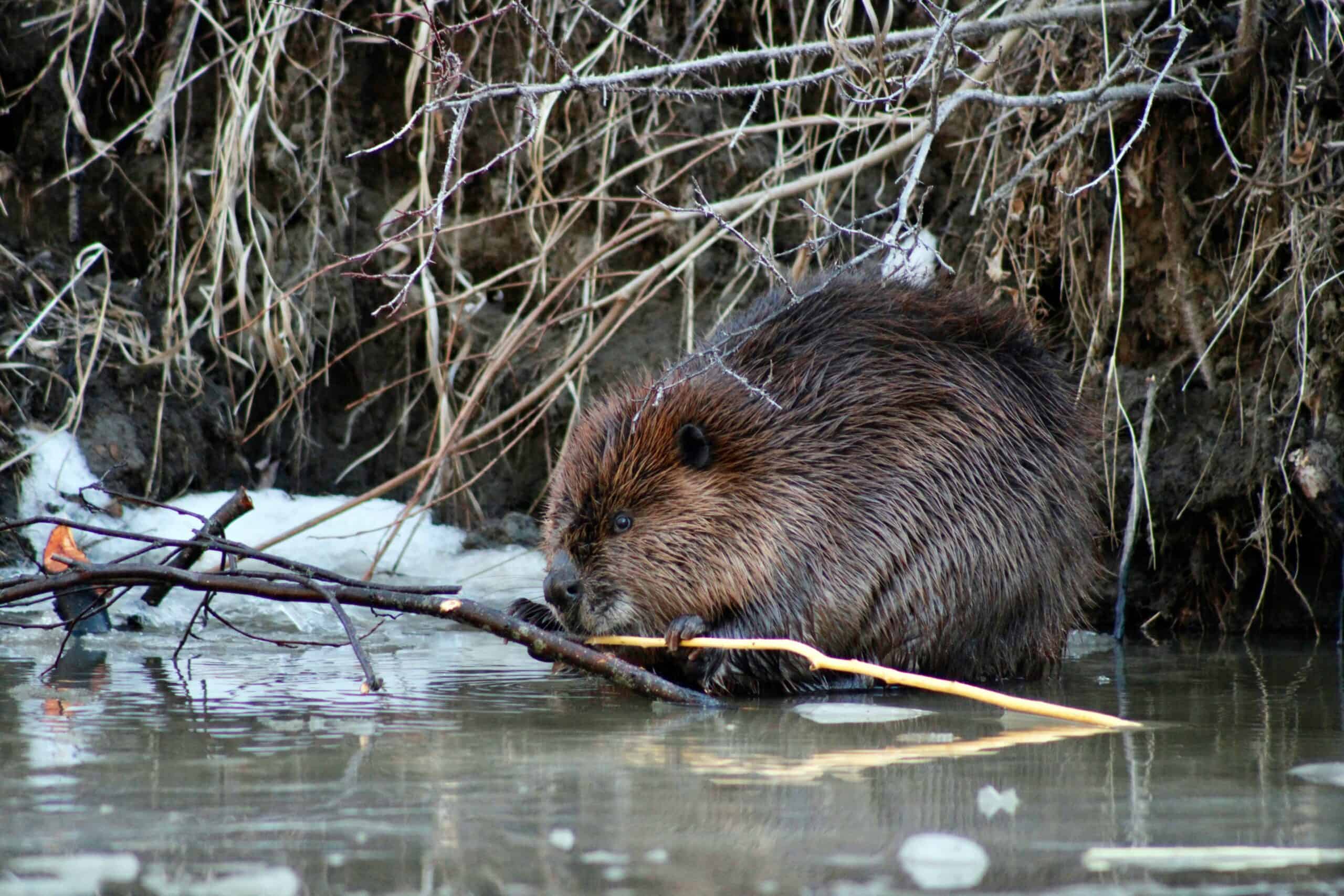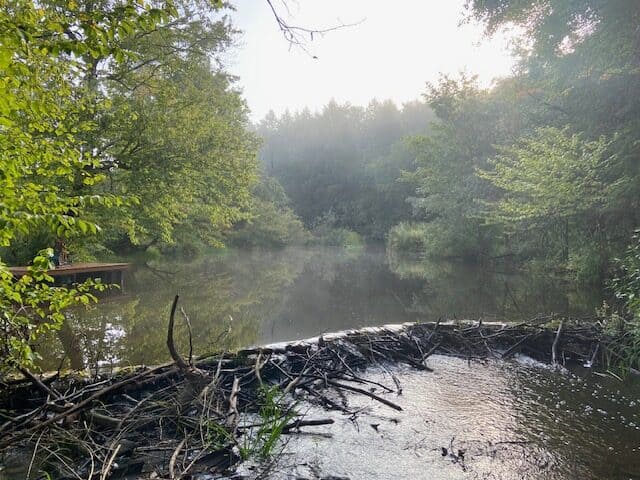
This blog is about the pros and cons of owning property that beavers find attractive. A beaver dam has been built on our creek almost every fall recently.
Beavers are fascinating creatures and beaver dams can have their benefits, but they can also be very destructive. Here are some things we’ve learned about beavers and about how to make them feel a little less welcome.
What attracts beavers to the property?
Beavers build dams across streams so that they can make a pond. The pond and a beaver lodge become home and give protection from natural predators.
When picking a dam site for their new neighborhood, beavers love certain features of our property:
-Plenty of trees and woody vegetation for building materials and for food.
– Manageable water flow that they can easily dam up
-A cove perfect for building a lodge
– Limited human disturbance and noise for uninterrupted work
-unprotected creek banks next to wooded areas
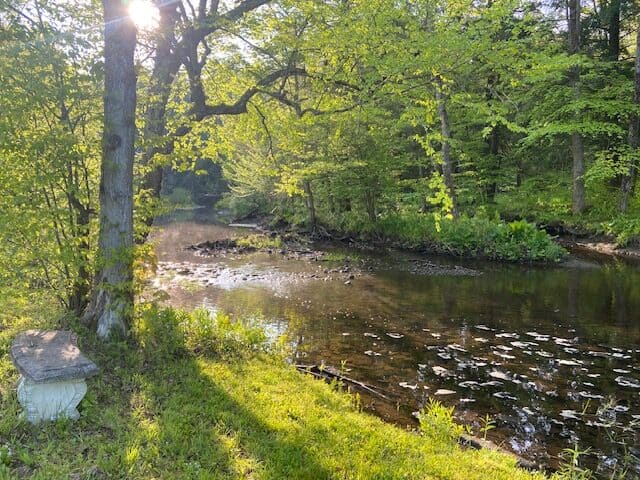
Beavers are hard working
How quickly beavers can build a beaver dam is impressive. Last season, they built a forty-foot-long dam about a foot high across the creek in less than three days.
They gnaw down trees for building material for dams and lodges and also for a food source. They eat the bark and the layer right below it (called the inner cambium layer).
They prefer certain species of trees – like aspen (because of how it is), poplar, cottonwood, willow and birch. We have plenty of these to choose from on our property, many trees in sapling form and easy for beavers to manage.
Our beavers start working at dusk and can be heard cutting and building throughout the night if left alone. They build more and cut and store more trees in the fall to be ready for winter.
.

Beavers are family oriented
Other than the problems they can cause, beavers have a lot of positive qualities.
They mate for life and have a strong family bond, centered around the mother, father, and the kids (called kits). Both parents help raise the kits and older siblings may also help with daycare.
The kits leave home after their second or third spring. They travel long distances by land and by water to find a mate and to start a new colony.
Beavers live about 10 to 12 years (if all goes well). They can live as long as 19 years in captivity. But before you invite Bucky home, you’ll want to keep in mind that owning a beaver is against the law in most states.
First the good news
Beaver dams can offer a lot of benefits to the ecology of an area.
Dams can act like filters, slowing down water flow and letting sediment and pollutants settle out of the water.
Dams can help with flood control. They can serve as natural buffers and store extra water after heavy rains. Water can then be released more gradually and sent downstream.
Dams also store water in the ponds they make and in groundwater. This can be very helpful during drier seasons.
Beaver dams can make or expand wetlands, which creates an important habitat for various plants, animals, creepy crawlies and insects.
They also create deadwood habitats by taking down trees. This makes more homes and food for an even bigger variety of plants and wildlife.
Wetlands can also preserve and protect an area if there are wildfires. They can act as a fire buffer and also might protect some species of plants from being wiped out.
Now the bad news:
How a beaver dam can change the lay of the land
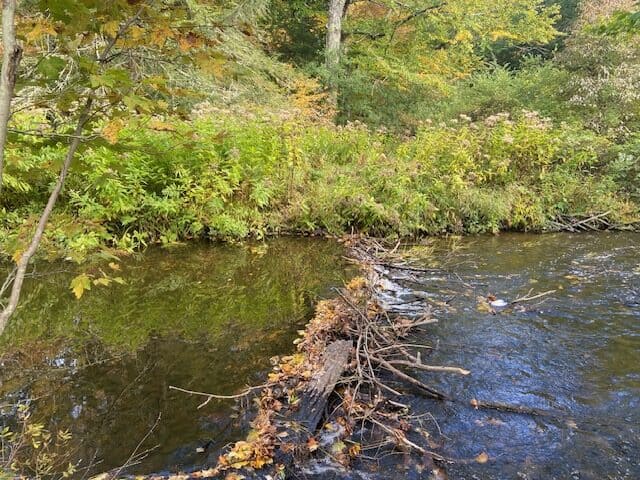
Beavers can quickly disrupt the ecosystem by changing waterflow of a creek and by stripping away trees and other vegetation. They can quickly raise the water level upstream and can flood large areas. On our property, it took about a week for an acre of forest floor to be underwater.
Dammed water can also become stagnant, which can lead to algae and the spread of disease.
Beavers take down a ton of trees to give them something to build with and for food. They also peel bark and the layer underneath (cambium layer) for food, possibly damaging much larger and more valuable trees. If given time they can do A LOT of damage to a wooded area.
A dammed stream or creek can also put a stop to fish migration. The creek that runs through our property is regularly stocked by the state with trout so this is a real concern for us.
How much wood would a beaver chuck….
How much wood would a woodchuck chuck
If a woodchuck could chuck wood?
A woodchuck would chuck as much as a woodchuck could chuck
if a woodchuck could chuck wood.
I didn’t understand this riddle when I was a kid. I took shuck to mean peal away layers. And I never understood why they were asking about woodchucks and not asking about beavers. Because I knew the answer to that one.
They’d chuck a lot!!
How much damage could a beaver really do?
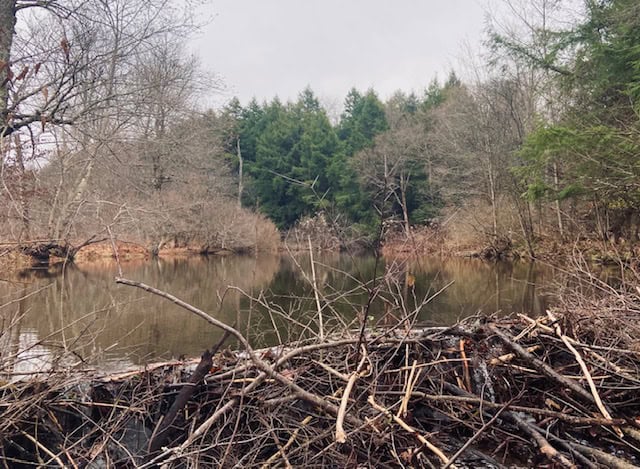
Beavers have extremely strong teeth and jaw muscles and are tree chewing machines. They can take down a 5 inch tree in a matter of minutes and can take down a medium size tree in a single night.
A pair of beavers can gnaw down 400 trees in a year! They prefer smaller trees (two to six inches) but can take down a tree with a thirty-three- inch diameter if they want to.
That’s a lot of wood chucked!
How big can a beaver dam get anyway?
Beaver dams are usually on the smaller side but can range from 9 or 10 feet long all the way up to 330 feet long. They can also get up to six feet high.
Beavers also build canals that can be as long as 1600 feet. They use them to transport food and building materials to deeper water.
The world’s longest known beaver dam is in Alberta Canada and is 2543 feet long and is visible from space (seems only fair that a beaver goes to space someday to see it). It took the beavers 30 years to build and the job was passed on from generation to generation.
And we thought OUR beaver dams were impressive!
How long DO beaver dams last?
The beaver dams on our creek have never lasted very long for a few reasons.
The spring thaw turns the creek into a fast flowing river and usually destroys anything in its way. We have Mother Nature to thank for very effective dam removal.
We’ve also learned to pay close attention and when a dam appears we get a DEC permit to remove it by hand. It’s incredible to see how logs, sticks, sod and stones are woven together to build a water stopping wall. Pulling away a portion lets the water behind it rush through and take portions of the dam downstream with it.
Left undisturbed, beaver dams can last for many years. Beavers continuously build and repair their dams, helping them to last for a long time.
Dams have been known to last as long as 150 years and some are thought of as a permanent part of the landscape.
Beavers also reuse dams and lodges and can live in the same area for generations.
Beaver dam eviction?
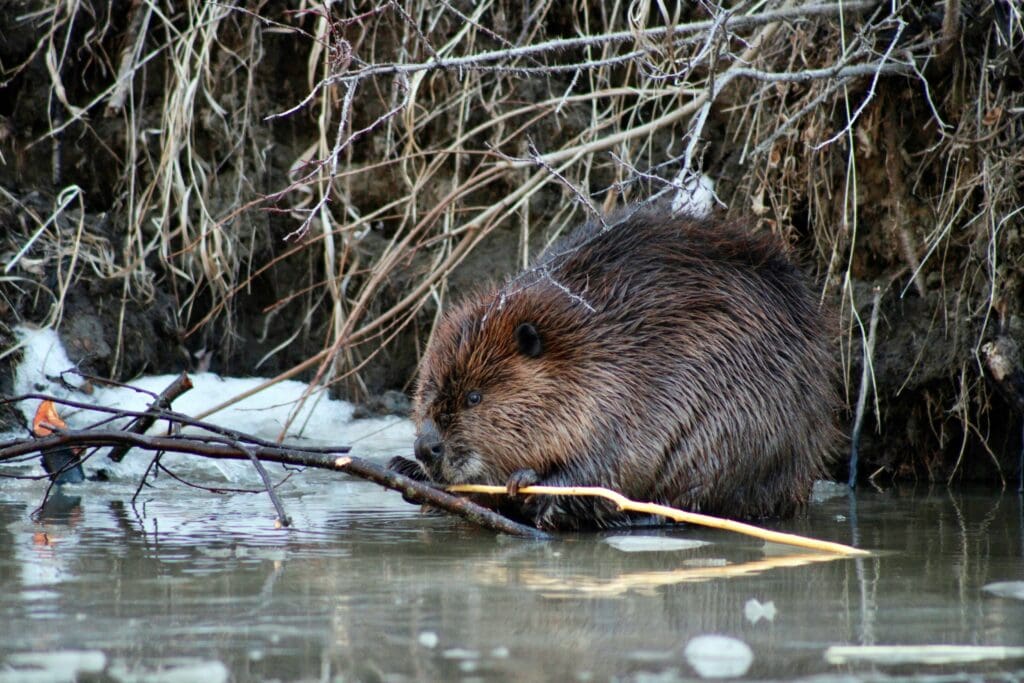
There were things we loved about beaver dams across our creek. A few seasons ago we had two dams at the same time 100 yards away from each other. At first the pond that was created behind the largest dam made a perfect skating pond in the winter and swimming area in the summer.
But the longer the dam stood the more stagnant the water became. There is also a parasite called Gardia that’s found in beaver ponds. It can make people pretty sick if they swallow any of the water.
A big portion of the lower lying woods was also turning into a swamp.
The biggest concern was watching sizeable trees being taken down and the roots of our centuries old hemlocks being gnawed to the bare wood. Those trees are sacred to us. The beavers had to move on.
The DEC is a great resource
I’m a familiar name at our regions Division of Fish and Wildlife. The folks there are very committed to protecting the ecology of the creek. After I explained what was happening with the dams, they agreed that the beavers were creating a problem site. I was issued a beaver damage permit and have been granted one almost every year since due to more beavers arriving.
As the property owner I’m able to trap any beavers and take apart the dam and beaver lodge using hand tools.
I can also give the permit to trappers in the area (The Division of Fish and Wildlife provided a list) and they can come onto the property to trap with my permission.
I like to think that our hard-working beavers were captured by the trappers in Havahart traps and were relocated with their family to a beaver sanctuary (maybe somewhere nice in Canada).

How to discourage beavers from making themselves at home
On our creek, we’ve learned to walk along the water often, being on the look out for any beaver building activity. We remove any dam or lodge beginnings and get rid of the wood. If the beavers are too quick for us and we find a completed dam (as recently as last year) we call Fish and Wildlife and ask for the usual.
There are a number of other recommended ways to discourage beavers. Some would be next to impossible to use in our ‘middle of the woods’ setting but worth sharing.
Fencing: Heavy mesh or electric fences can block hauling routes and access to favorite areas.
Water control devices: These devices allow water to flow freely, and not be blocked by dams. They look basically like a fenced off area in the water, with pipe running beyond the likely location of the beaver dam. The beavers figure, ‘What’s the point?’, and move along.
Repellents and deterrents:
Repellents like Ro-pel or Wolf Urine may be helpful. Castor oil, ammonia, lighting (for less building privacy), noise makers and predator decoys might also help to some degree.
Coolest way? Bring flowers!

Beavers avoid certain flowers and trees and planting them by the creek could be helpful – not to mention beautiful!
Word is that they don’t like daffodils, rhododendrons, and evergreens. If it works that would be great, and if it doesn’t we’ve added landscaping and color to the waters edge.
Saying goodbye to our transient beaver
Last year, the beavers were back and another dam was built in about three days. It was shorter than the dams from past years (about a foot high) but we knew where things were headed. I called Fish and Wildlife, got a permit, and called a trapper in the area.

Traps were set and the trapper breached part of the top of the dam. Beavers will arrive at dusk to fix the damage. No beavers were caught and the dam was not fixed, which meant the builder had moved on.
A transient beaver, the trapper called it. The wandering beaver did a ton of work and then went on his way.
I picture him looking back and thinking, ‘I left it better than I found it’.
Best of luck downstream, Mr. Beaver. Until we meet again!
Thanks to Unsplash for a few of the photos – Contributors include:
Photo by Yoksel 🌿 Zok on Unsplash
